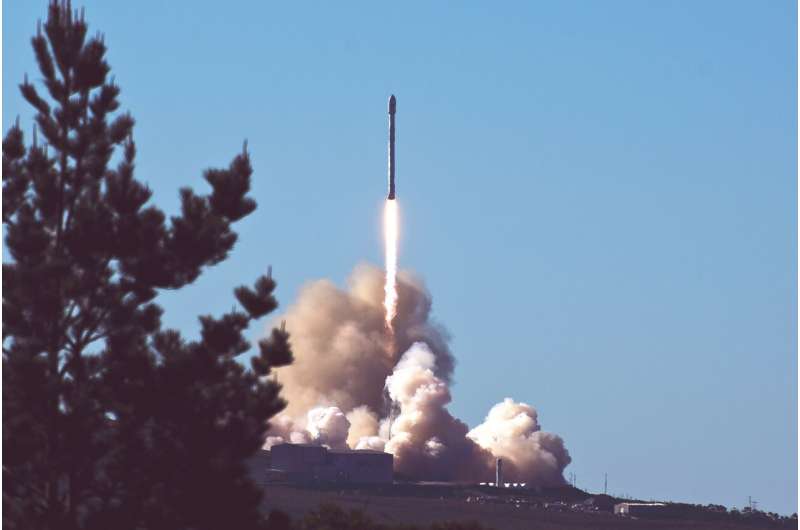This article has been reviewed according to Science X's editorial process and policies. Editors have highlighted the following attributes while ensuring the content's credibility:
fact-checked
reputable news agency
proofread
SpaceX returns to flight with Falcon 9 launch from Kennedy Space Center

After more than two weeks grounded by the Federal Aviation Administration, SpaceX returned to launching its workhorse Falcon 9 lifting off early July 27 from Kennedy Space Center.
The rocket took off at 1:45 a.m. carrying 23 of the company's Starlink internet satellites from KSC's Launch Pad 39-A.
The first-stage booster made its 17th trip to space and managed another recovery landing on the droneship Just Read the Instructions stationed downrange in the Atlantic.
It was the 51st launch from the Space Coast for the year, with all but three coming from SpaceX. Including California, it was the 71st operational mission for SpaceX, not including two test launches of its Starship and Super Heavy rocket from Texas.
The company's frenetic launch pace this year was ground to a halt by the FAA after a July 11 launch from California ended in a failure of the Falcon 9's upper stage.
The failure was due to liquid oxygen leak that caused its second stage engine to ice over in between its initial burn and a planned second burn to raise its orbit before deploying its payload. No second burn occurred, and the 20 Starlink satellites on board, which did manage to be deployed, were at too low an altitude and ultimately burned up on reentry in the Earth's atmosphere.
SpaceX's mishap investigation found the leak came from a crack in a sense line for a pressure sensor that was located on the rocket's oxygen system.
"Our teams have been performing this comprehensive review with FAA as part of the formal investigation process, but also of all of our SpaceX vehicles and our ground systems including Dragon so we wanted to ensure we've been meticulous and thorough with what we've learned as we return to flight," said SpaceX's Sarah Walker, who was speaking at a preview press conference for Crew-9, the next planned human spaceflight for SpaceX next month.
To remedy it for now, SpaceX removed the sense line and sensor on its fleet of Falcon 9 second stages saying it could track data with other sensors.
It also removed certain other sense lines on other parts of the Falcon 9 to be overly cautious, she said.
"It's not related to the flight safety system in any way. It's not used for that system, so we're able to just remove it. It's redundant with alternate sensors we already have present on the engine," she said. "That design change has actually already been tested at our rocket development facility in McGregor, Texas."
The FAA accepted the investigation results and cleared the rocket for a return to flight for all of its planned missions including human spaceflight.
Walker noted that on Dragon launches, no second burn of the upper stage is required, and that's a feature used on certain satellite missions. The Saturday launch featured such a burn, and the upper stage was able to perform it as planned, deploying the Starlink satellites into their proper low-Earth orbit.
Now that SpaceX is back to launching, it has a busy manifest lined up for the next month.
It also has a resupply mission flying Northrop Grumman's Cygnus cargo spacecraft to the International Space Station slated to launch from Cape Canaveral as early as Aug. 3.
It could also launch two human spaceflights from the Space Coast in August with the Crew-9 rotational mission from KSC as early as Aug. 18 and the private orbital Polaris Dawn mission featuring billionaire Jared Issacman also potentially in August.
"It was really incredible to see how quickly the team was able to identify the cause of the mishap and then associated corrective actions to ensure success of future missions," Walker said.
2024 Orlando Sentinel. Distributed by Tribune Content Agency, LLC.





















